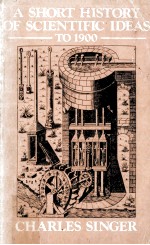

A Short History of Scientific Ideas To 1900PDF电子书下载
- 电子书积分:16 积分如何计算积分?
- 作 者:
- 出 版 社:Oxford University Press
- 出版年份:1959
- ISBN:0198810490
- 页数:525 页
INTRODUCTION.Nature of the Scientific Process 1
1.What is Science? 1
2.Origins of the Scientific Tradition 2
Ⅰ.RISE OF MENTAL COHERENCE.The Foundations:Mesopotamia,Egypt,Ionia,Magna Graecia,Athens,to c.400 B.C 6
1.First Systematization of Knowledge 6
2.Beginnings of Ionian Science and the Eastern Greek School 12
3.Pythagoreans and the Western Greek School 22
4.Fathers of Athenian Science 31
Ⅱ.THE GREAT ADVENTURE.Unitary Systems of Thought:Athens,400-300 B.C 38
1.Plato and the Academy 38
2.Aristotle 45
3.Peripatetics,Stoics,and Epicureans 56
Ⅲ.THE SECOND ADVENTURE.Divorce of Science and Philosophy:Alexandria(300 B.C.-A.D.200) 62
1.Early Alexandrian Period(300-200 B.C.) 62
2.Archimedes.Rise of Mechanics 69
3.Middle Alexandrian Period 200-c.30B.C 75
4.Late Alexandrian Period to A.D.200 85
(ⅰ)Physical and Mathematical Knowledge 85
(ⅱ)Ptolemy.Astronomy and Geography 89
(ⅲ)Late Alexandrian Biology 98
(ⅳ)Late Alexandrian Alchemy 101
Ⅳ.THE FAILURE OF INSPIRATION.Science the Handmaid of Practice:Imperial Rome(50 B.C.-A.D.400) 103
1.Development of the Roman Attitude to Nature 103
2.Geography and Imperialism 108
3.Imperial Organization of Medicine and Hygiene 114
4.Roman Mathematical,Mechanical,and Calendarial Science 121
5.Roman Astronomy and Astrology 126
6.Passage from Pagan to Christian Thought 131
Ⅴ.THE FAILURE OF KNOWLEDGE.The Middle Ages:Theology,Queen of the Sciences(c.A.D.400-c.1400) 137
1.The Dark Age in the West(400-1000) 137
2.Science in the Orient(750-1200) 140
(ⅰ)Byzantines and Moslems 140
(ⅱ)Alchemy in Eastern Islam 144
(ⅲ)Medicine in Eastern Islam 147
(ⅳ)Mathematics and Astronomy in Eastern Islam 148
(ⅴ)Physics in Eastern Islam 151
(ⅵ)Science in Western Islam 154
3.Oriental Penetration of the Occident to c.1100 156
4.Mechanism of Translation from Arabic to Latin 158
5.Early Western Translators from Arabic(1100-1300) 162
6.Scholasticism and Science(1200-1400) 164
7.Some Main Personalities of Scholastic Science 169
8.Status of Medieval Science 175
9.Medieval Science and Useful Arts 178
Ⅵ.REVIVAL OF LEARNING.Rise of Humanism:Attempted Return to Antiquity(1250-1600) 188
1.Humanism 188
2.Printing of the Ancient Scientific Classics 193
3.Scientific Atmosphere of the Early Renaissance 196
4.Practical Arts in the Sixteenth Century 200
5.Encyclopaedic Naturalists of the Sixteenth Century 207
6.Anatomy and Physiology in the Sixteenth Century 210
7.Astronomical Observation and Hypothesis in the Sixteenth Century 212
Ⅶ.THE INSURGENT CENTURY.Downfall of Aristotle(1600-1700):New Attempts at Synthesis 218
1.Doctrine of the Infinite Universe 218
2.Mathematics becomes the Instrument of Physical Investigation 223
3.Physico-Mathematical Synthesis 230
4.Kepler's re-formation of the Heavens 236
5.Galileo's Astronomical Discoveries 242
6.Some Philosophical Implications of Galileo's Views 246
7.Some Physical Implications of the Galilean Revolution 249
8.Prophets of Science 259
9.Character and Conduct of Matter 268
10.Mechanical Concepts in Biology 274
(ⅰ)First Application of Physics to Physiology 274
(ⅱ)The Physiological Sects 279
(ⅲ)The Classical Microscopists and Spontaneous Generation 282
Ⅷ.THE MECHANICAL WORLD.Enthronement of Determinism(1700-1850) 288
1.The Newtonian Key to the Mathematics of the Heavens 288
2.Morphology of the Universe 297
(ⅰ)Observational Astronomy 298
(ⅱ)Dynamical Astronomy 309
(ⅲ)Astrophysics 314
3.Terrestrial Globe 316
(ⅰ)Measurement of the Earth and Cartography 316
(ⅱ)Wind,Water,and Terrestrial Magnetism 321
(ⅲ)Early Views of Earth-History 325
(ⅳ)Stratigraphy 329
4.Transformations of Matter 332
(ⅰ)Rise of Quantitative Method 332
(ⅱ)Intensive Study of Chemical Reaction 335
(ⅲ)Gases 337
(ⅳ)The Elements 339
(ⅴ)Atomism 341
(ⅵ)Molecular Theory 344
5.Transformations of Forces 347
(ⅰ)The Imponderables 347
(ⅱ)Temperature Measurement 348
(ⅲ)Heat a Mode of Motion 350
(ⅳ)Static Electricity 353
(ⅴ)First Study of Current Electricity 355
(ⅵ)Electromagnetism 358
(ⅶ)The Dynamo 361
(ⅷ)The Magneto-Electric Field 364
(ⅸ)Undulatory Theory 367
(ⅹ)Doctrine of Energy 375
6.Biology becomes Systematized 378
(ⅰ)Early Classificatory Systems 378
(ⅱ)Main Subdivisions of Biological Study 382
(ⅲ)Naturphilosophie 384
(ⅳ)Correlation of Parts 391
(ⅴ)Distribution of Living Things 395
7.Physical Interpretation of the Living Organism 402
(ⅰ)Beginnings of Modern Physiology 402
(ⅱ)Foundations of Bionomics 406
(ⅲ)Cell Theory 410
(ⅳ)Protoplasm 414
Ⅸ.CULMINATION OF THE MECHANICAL VIEW OF THE WORLD(c.1850-c.1900) 417
1.Note on Delimitation of the Period 417
2.Nature of the Galilean-Newtonian Revolution 418
3.Physics 422
(ⅰ)Sound 422
(ⅱ)Heat 422
(ⅲ)Optics 427
(ⅳ)Electromagnetism 432
(ⅴ)Spectroscopy 438
4.Astronomy 441
5.Chemistry 453
6.Mechanization of Biology 461
(ⅰ)Microbiology 461
(ⅱ)Embryology and Embryogenesis 470
(ⅲ)Rise of Genetics 483
(ⅳ)Physiological Synthesis 490
(ⅴ)Evolution 500
(ⅵ)The Turn of the Century 515
INDEX 517
- 《中国“80后”大学教师胜任力评价研究=RESEARCH ON THE EVALUATION OF CHINA'S POST 80s GENERATION UNIVERSITY TEACHERS' CO》黄艳著 2013
- 《解读好莱坞:电影的空间与意义》Deborah Thomas著;李达义,曹玉玲译 2004
- 《会说话的星图 星座篇》徐历涛著 2014
- 《可靠性工程与风险管理 第3辑 英文版》赵衍刚编 2012
- 《竞争战略 全译珍藏版》(美)迈克尔·波特(Michael E. Porter)著 2012
- 《中国材料名师讲坛 第1辑》谢建新主编 2012
- 《翻译能力的培养》舍夫娜,阿达巴编 2012
- 《大学生外语口语焦虑 自我图式的视角 for university students: in the view of self-schema》巫文胜著 2014
- 《都柏林大学的教育内涵与实践 探索世界高水平大学发展之路 explore the development of the world high-level university》李全宏编著 2013
- 《物理学 卷1 力学和热学 医学、生物等专业适用 英文改编版原书第4版》AlanGiambattista,BettyMcCarthyRichardson著 2013
